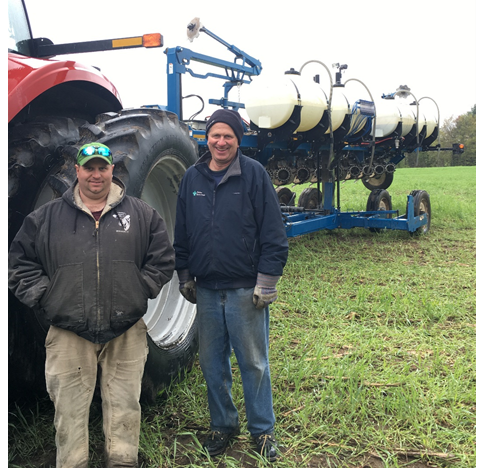
Jeremy (left) and George (right) Foster in front of their no-till planter on a rainy Tuesday afternoon. Not a great day for no-till planting, but a perfect day for an on-farm workshop!
By Nina Gage, VT Agency of Agriculture, Food & Markets
Foster Brothers Farm in Middlebury, Vermont, manages 2200 acres of farmland including about 1600 acres of tillable land. The majority of their annual cropland is managed with a system of no-till planting and cover cropping. “It’s night and day,” exclaims George, “With no-till, we don’t disturb the soil structure.” The transition to no-till planting at Foster Brothers Farm has provided the farm with flexibility in their nutrient management planning, their rotations, as well as resiliency during dry and wet seasons.
George Foster and his son Jeremy have been planting corn with their Kinze 3600 no till corn planter for seven years. Originally funded by an Agency Capital Equipment Assistance Program (CEAP) grant in 2012, the planter has since seen some upgrades which has enabled the Foster Brothers Farm to fully transition into a no till planting system. These include hydraulic downforce, row clutches, changing from disc closing wheels to schlagers, as well as precision agriculture upgrades in the seed tube monitoring and autosteer. Jeremy insists he can plant straighter rows without using the autosteer, but a more accurate GPS system would likely do the trick as well.
Cover crops are a major aspect of the Foster’s no till system. They harvest their own cover crop and store it in bins with drying floors. They have historically broadcast winter rye cover crop seed after corn harvest. The Foster’s built a custom roller crimper to mount on the front of their tractor in order to help terminate the cover crop at the time of planting. This year they will be planting a mix of oats and rye. “Cover crop is essential,” George explained, as it keeps the soil structure loose.
Foster Brother’s Farm recently hosted a No-Till Training with UVM Extension for service providers in the region where George explained how the farm has transitioned, and some of the major steps along the way. These include attending the No-Till & Cover Crop symposium, as well as working closely with UVM Extension on no till and cover crop trials. Last year, the Foster’s borrowed UVM Extension’s 10-foot no till grain drill for planting cover crop trials along Route 116. George told the group visiting his farm, with a 10-foot drill, “you’re out there all day, and you get a little bit done.” Luckily for George, the Foster Brothers Farm was recently awarded a grant through the CEAP program for a 30-foot Landoll 5531 folding no till grain drill. This equipment will help bring their cover cropping system to the next level.
Other recent management changes for the Foster Brothers include dragline grassland shallow slot manure injection by Matthew’s Trucking with support from UVM Extension and Agency of Agriculture clean water funding. The State and Extension Service have enabled resources to help Vermont farmers protect water quality. It is about making decisions for the future of the land and environment. Planting in a different way or changing land management can create risk and uncertainty, but as George claims, “Well that’s farming!”
To learn more about the CEAP program and eligible equipment, you can visit https://agriculture.vermont.gov/ceap or call the Agency at 802-828-2431.

